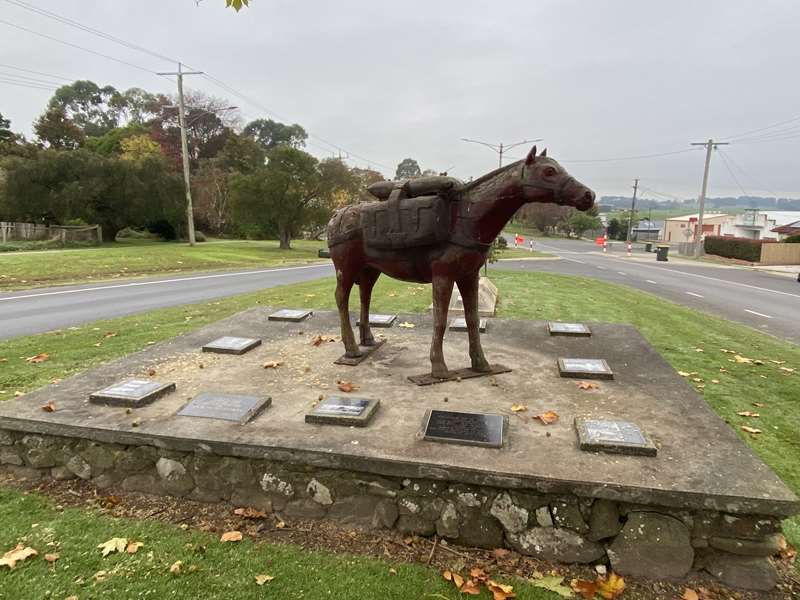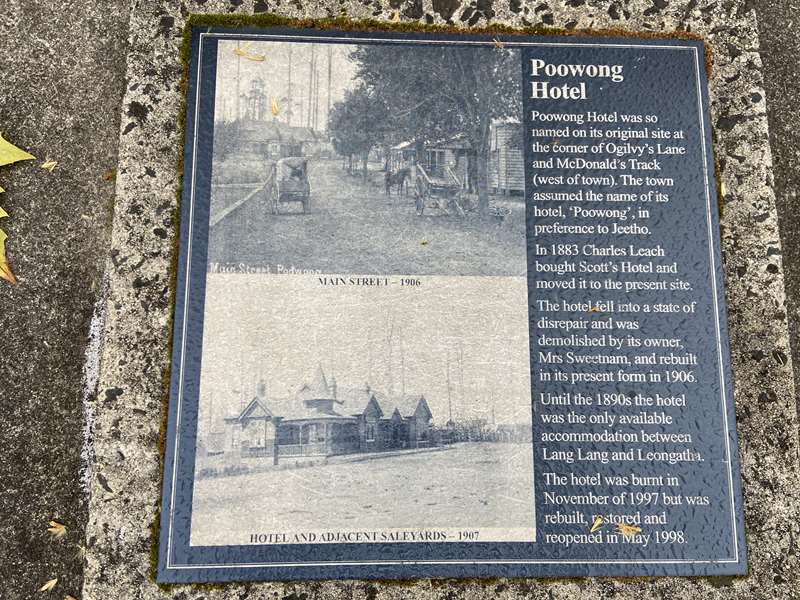Poowong - Pioneer Pack Horse & Historical Plaques


On the median strip is a sculpture of a pioneer pack horse, which was unveiled on 18th April 1999, to honour James and Elizabeth Scott, the first settlers of Poowong and mark the 125th anniversary of Poowong settlement.
Nine pictorial plaques of Poowong's history were added to the surrounds of the pioneer pack horse sculpture in 2008 through a joint project between Poowong Community Consultative Committee and the Poowong Historical Group.
The historical plaques are:
Dairy Industry
The main industry for early settlers, was dairying, their cattle could graze in small cleared areas.
Poowong Butter Factory commenced in 1892. It struggled and was forced into liquidation in 1911. The community had faith and reopened it less than 10 days later funded by locals.
A.G. Buchanan took over the factory in January 1930 from Goodrich Products Pty Ltd. The business grew and new processes were introduced.
Collection of whole milk commenced in 1937. Previously only cream had been collected. Mr Buchanan retired in 1968.
Local dairy manufacturing saw many changes during the ensuing decades and the factory closed in 1985.
Transport
High rainfall and mud were restricting factors for early transport to Poowong. Passenger services and milk collection rounds were gruelling for man, beast and machine.
Coach services from Drouin began in May 1879. With "roads" churned to mud, many breakdowns occurred and passengers often had to walk through mud up to their knees.
The original service operated on Tuesdays, Thursdays and Saturdays, returning to Drouin on Mondays, Wednesdays and Fridays. This service lasted, off and on, until 1890 when the Great Southern Railway was opened to Nyora and Loch. In 1896 a daily coach service between Poowong and Loch took over an hour.
Recreation
Organised sports and recreation came early to the Poowong community.
A cricket club appeared in 1880 followed by a sports association, football club, tennis, racing, roller skating, rifle shooting and even draughts and a debating society.
The first swimming pool was located on the Bass River south of the town.
Poowong Hotel

Poowong Hotel was so named on its original site at the Comer of Ogilvy's Lane and McDonald's Track (west of town). The town assumed the name of its hotel, 'Poowong', in preference to Jeetho.
In 1883 Charles Leach bought Scott's Hotel and moved it to the present site.
The hotel fell into a state of disrepair and was demolished by its owner, Mrs Sweetnam, and rebuilt in its present form in 1906.
Until the 1890s the hotel was the only available accommodation between Lang Lang and Leongatha.
The hotel was burnt in November of 1997 but was rebuilt, restored and reopened in May 1998.
Early Agriculture
Poowong's soil which had sustained the Great Southern Forest was naturally abundant. The fires cleared huge trees and agriculture in the area moved forward rapidly.
The major restricting factor to the marketing of produce was the still poor access on rough and muddy roads.
The Great Fires of 1898
"Red Tuesday" 1st February, 1898
Ringbarked trees and timber torn down by a tornado three years prior fuelled the fire which originated near Warragul. Fanned by a 60 mile an hour gale of hot, north-east wind there was little selectors could do.
The trail of fallen timber led the fire through the Danish settlement and North Poowong, missing nothing, 20 miles in three hours. No human lives were lost but sheep were roasted as they sheltered; there were piles of dead cattle at every gate entrance.
The intensity of the fires cleared timber that would have ordinarily taken years of manual labour.
The First Public Building
In 1878 the first public building in the South Gippsland hill country, the Wesleyan (Methodist) Church, was built surrounded by forest on the corner of McDonald's Track and South Road.
The structure was built by L.C. Holmes from pit sawn bluegum timber felled opposite the site. This building also served as the first school and was used by the Church of England until their own buildings were erected.
In 1981 the building was purchased by the Poowong Historical Group Inc. and is now known as "The Pioneer Chapel".
Early Days
In the beginning the Poowong district was an inhospitable, dense rainforest. Transient aborigines passed through via the Bass River.
Paul Edmund de Strzelecki traversed this district in 1840, but it was not until 1860 that the first surveys of McDonald's Track were begun by G.T. McDonald.
Giant trees and saplings up to 200 feet high with a second layer of smaller trees, then ferns, sword-grass and a tangle of small undergrowth would make clearing slow for selectors.
On 17 April, 1874, James Scott, the first selector pegged Lot 5, Parish of Poowong in the name of his son, Robert G. Scott.
A steady stream of hardy selectors would follow.
Photos:
Location
13 Ranceby Road, Poowong 3988 Map









